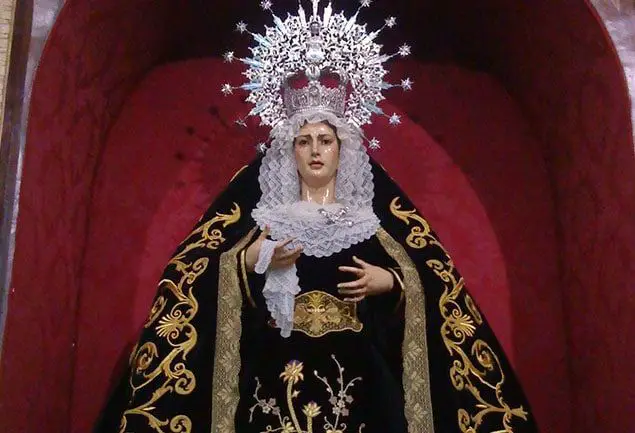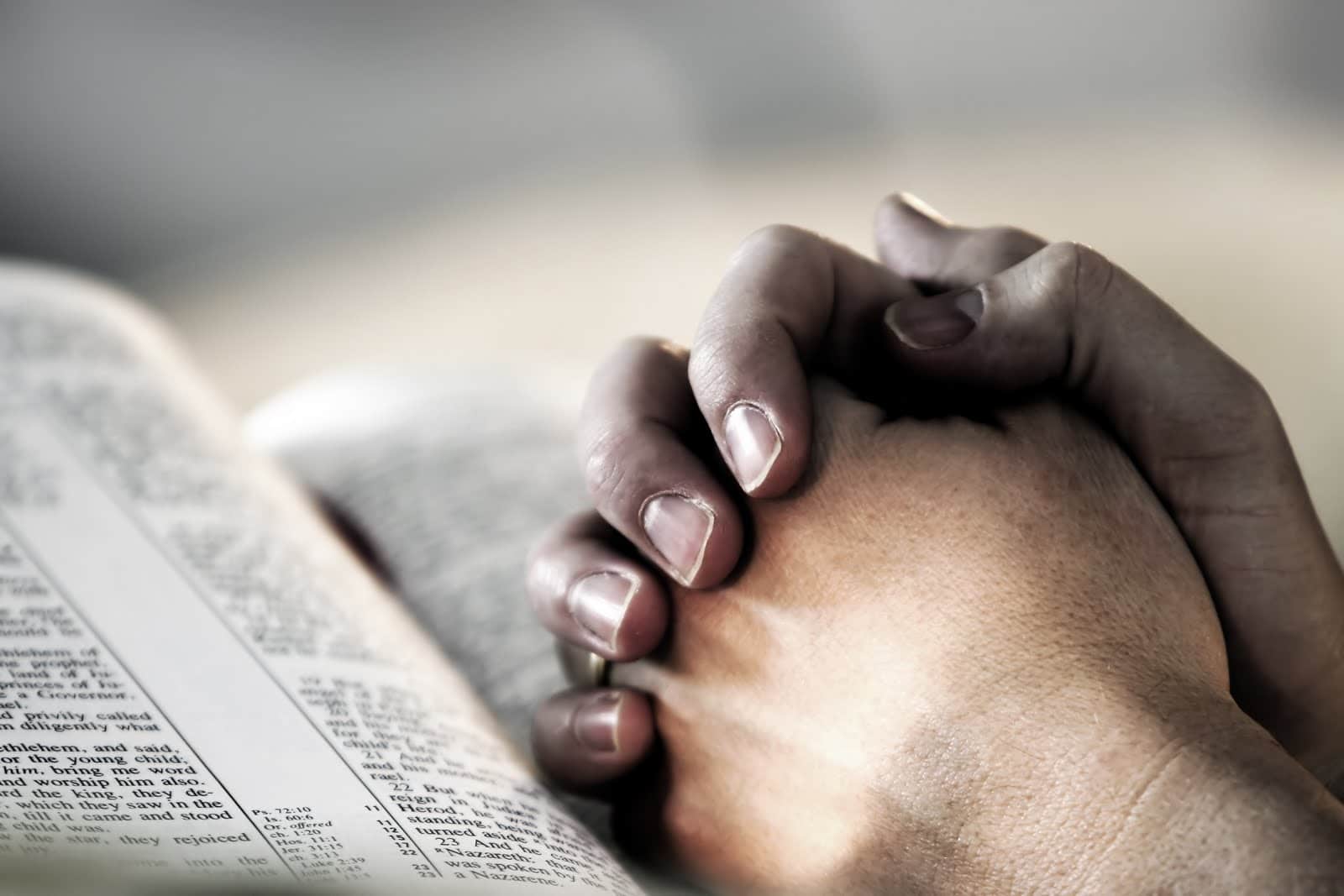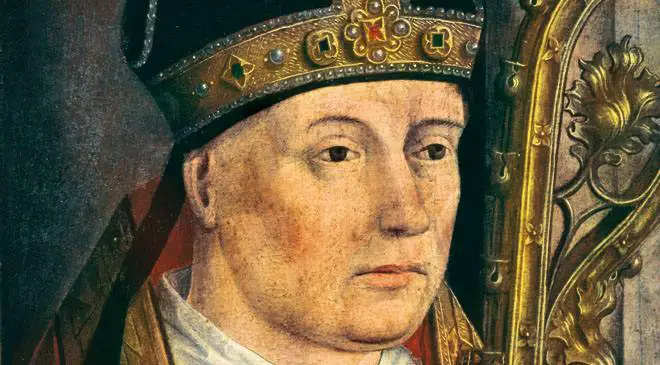Virgen de la Caridad del Cobre, also known as Our Lady of Charity of El Cobre, is a popular Marian title for the Blessed Virgin Mary. Several Marian images known by the same title exist around the world, while a particular Hispanic image is pontifically designated by Pope Benedict XV as the patron saint of Cuba.
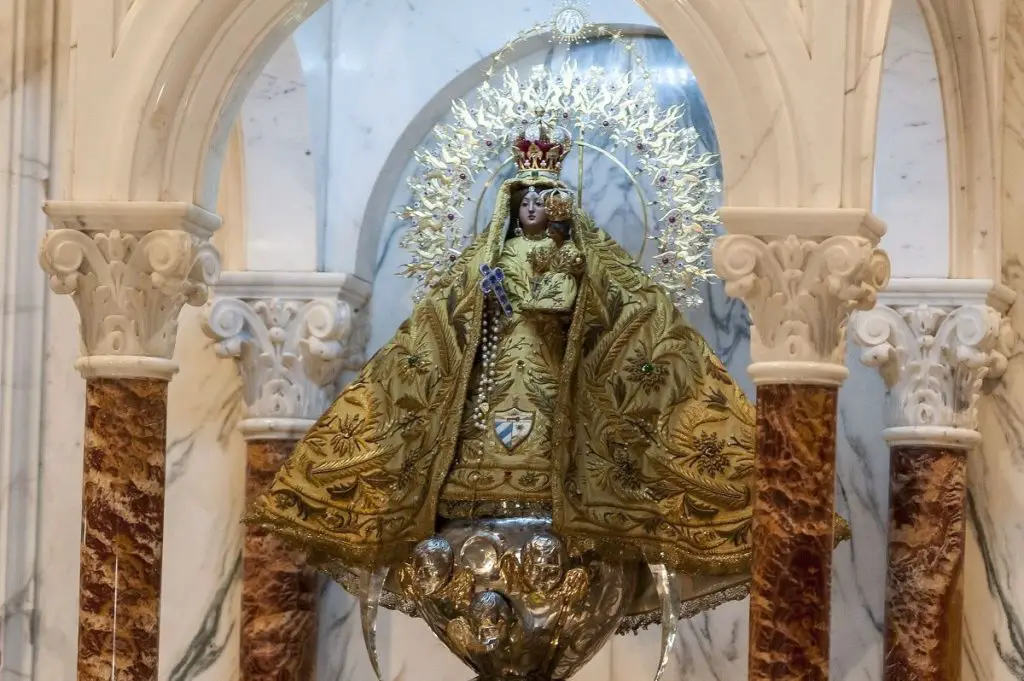
The image venerated in Cuba is about 16 inches high; the head is made of baked clay covered with a polished layer of fine white powder. His feet rest on a shining moon, while angels spread their golden wings on a silver cloud. The Child Jesus raises his right hand in blessing and holds a golden globe in his left hand.
History of the Virgen de la Caridad del Cobre (Our Lady of the Charity of El Cobre)
Its history begins around 1612. It is believed that her image was brought by Spanish settlers from the town of Illescas, in the province of Toledo, Spain, along with other virgins such as the Virgen del Rocio or the Virgen de la Altagracia, where a similar image of the Virgin of Charity is venerated.
At the beginning of the 16th century, Spanish missionaries went to Cuba to evangelise the native population and convert them to Catholicism. Cuba had very little gold and silver compared to places like Mexico and Peru, but it was still a valuable colony for Spain because of its strategic location as a stopping point for ships sailing between Spain and the New World. Cuba also had rich and fertile land that lent itself to cattle ranching and agriculture. These were lucrative enterprises as they provided the sailors with food for the long ocean voyage.
In the eastern part of the island is Nipe Bay, which was an important source of salt for curing meat. Around 1612, three boys were collecting salt and the Virgin appeared to them in a vision. Traditionally, they are known as the “three Johns”, although records show that one of them was actually called Rodrigo.
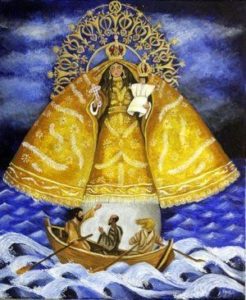 They were in a small boat and saw something white appear on the top of the waves. As they approached, they saw that it was the figure of the Virgin Mary holding the Christ Child in her arms. They noticed that her clothes were not wet and that she was standing on a wooden tablet which read “I am the Virgin of Charity”. The boys returned to the shore and reported what they had seen to the supervisor of the copper mines in the area. Realising that the boys had seen a statue of the Virgin, the manager of the El Cobre mines asked for a shrine to be built in her honour, and it was. But, as the story goes, the Virgin kept disappearing and reappearing at the site.
They were in a small boat and saw something white appear on the top of the waves. As they approached, they saw that it was the figure of the Virgin Mary holding the Christ Child in her arms. They noticed that her clothes were not wet and that she was standing on a wooden tablet which read “I am the Virgin of Charity”. The boys returned to the shore and reported what they had seen to the supervisor of the copper mines in the area. Realising that the boys had seen a statue of the Virgin, the manager of the El Cobre mines asked for a shrine to be built in her honour, and it was. But, as the story goes, the Virgin kept disappearing and reappearing at the site.
The local people decided that the Virgin had to move and she was placed in the Templo Parroquial del Cobre, near Santiago de Cuba. From then on she was known as La Virgen de la Caridad del Cobre. But the Virgin kept appearing and disappearing, so the people decided that she wanted to be in the mountains of the Sierra Maestra. This coincided with another vision of the Virgin that took place on the mountainside near the copper mines. A young girl called Apolonia claimed to have seen the Virgin while picking flowers. Although not everyone believed the girl, it was decided that it would be better to move the statue of the Virgin to that place.
Today the image is enshrined in the National Shrine of the Basilica of Our Lady of the Charity of the Cobre, built in 1926 in the town of El Cobre, near Santiago de Cuba. Pope Pius XI gave the image canonical title on 20 December 1936. The feast day of Our Lady of Charity is 8 September. This colonial-style basilica has the same solemnity as the Basilica of the Virgin of Guadalupe in Mexico.

Cubans affectionately call her “Cachita”. When Ernest Hemingway, the great writer and winner of the Nobel Prize for Literature, received his award, he decided to give the metal medallion to the Virgin to show his love for Cuba.
We invite you to watch the video below to learn more about the history of the Virgen de la Caridad del Cobre, Patroness and Mother of Cuba:
Prayer to the Virgen de la Caridad del Cobre,
Patroness of Cuba
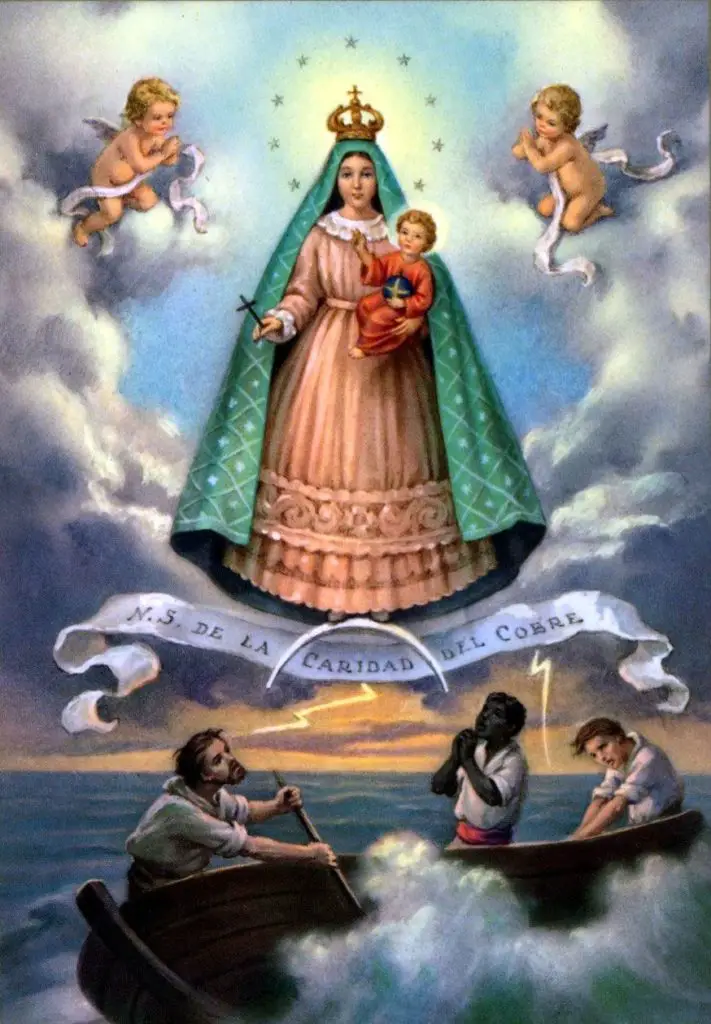
Holy Mary of Charity, who came as a messenger of peace,
Floating on the sea.
You are the mother of all Cubans.
Today, Holy Mother of God,
We honour you with the love of our children.
In your motherly heart we place our aspirations and hopes,
Our worries and our many petitions;
For the torn homeland,
So that together we may build
Peace and harmony.
For families, that they may live
with fidelity and love.
For children, that they may grow up healthy
Physically and spiritually.
For young people, that they may affirm their faith
and their responsibilities in life and
and give meaning to their lives.
For the sick and the marginalised,
For those who suffer from loneliness,
For those who are far from home,
And for all those who suffer in their hearts.
For the Cuban Church and its evangelising conscience;
For priests and deacons;
Religious and lay people.
For the victory of justice and
For the victory of justice and love in our people.
Mother of Charity,
Under your protection we take refuge!
Blessed are you among women!
And blessed is Jesus, the fruit of your womb!
To Him be glory and power,
Forever and ever. AMEN.
The prayer ends with an Our Father, 3 Hail Marys and a Glory Be.
There are many prayers to the Virgen de la Caridad del Cobre, in this video you can hear the prayer to the Virgin and the prayer of Pope John Paul II when he crowned the Virgin during his visit to Cuba:
Novena to the Virgen de la Caridad del Cobre (Our Lady of the Charity of the Cobre)
For Catholics, novenas are ways of praying and asking the Virgin for health petitions, just as they do when they pray the Holy Rosary, these prayers are used to solve personal problems, work problems, etc. The novena to the Virgen de la Caridad del Cobre (Our Lady of the Charity of El Cobre) is like this:
Act of repentance: I confess before Almighty God and before you, my brothers and sisters, that I have sinned greatly in thought, word, deed and omission: through my guilt, through my guilt, through my great guilt. Therefore, I pray to the ever-virgin Mary, to the angels, to the saints and to you, my brothers and sisters, to intercede for me before God our Lord.
Prayer for every day: Remember, O most pious Virgin Mary, that it has never been said that anyone who has come to you and implored your help and asked for your help has never been abandoned by your presence. Encouraged by this confidence, I too come to you, O Virgin, Mother of Virgins, and although I groan under the weight of my sins, I dare to appear before your most holy sovereign presence. Do not refuse my humble entreaties, O most pure Mother of God, but listen to them graciously. This is so.
First day: Hail God, how my soul rejoices, most loving Virgin, with the sweet memories that this greeting awakens in me! My heart is filled with joy as I say the Hail Mary to accompany the joy that filled your spirit when you heard it from the mouth of the angel, rejoicing in the choice that the Almighty made of you to give us the Lord Jesus. (Ask for the favour you wish to obtain).
Second day: Mary, holy name! Seal with your name, most gracious Mother, the memorial of our petitions, and give us the consolation that your Son, Jesus, will graciously hear them, so that we may attain full conviction in the practice of our religious duties, firm confirmation in Christian virtues, and unceasing desire for our eternal salvation.
Third day: Full of grace, O sweet Mother! Hail Mary, most rich tabernacle in which the fullness of the Divine dwelt bodily: at your feet we present ourselves today so that the grace of God may be abundantly spread in our poor souls, purifying them, enlarging them and increasing in them day by day the true love of God and of our brothers and sisters.
Fourth day: The Lord is with you: O Blessed Virgin! The immense Lord, who is in all things by His nature, is in you and with you in a most supreme way. My Mother, let him come to us through you. But how can He come to a heart filled with so much dirt? The Lord who, to make you His dwelling place, wished with such a miracle that you should not lose your virginity as a mother? Oh, let all uncleanness die in us!
Fifth day: Blessed art thou among women. You, O Virgin Mary, are the glory of Jerusalem, you are the joy of Israel, you are the honour of our people. If through one woman, Eve, so many tears were shed in the world, through you salvation came to us. For this you will always be blessed. Grant us a living and working faith to contemplate and imitate the great deeds that God has done in you and through you.
Sixth day: Blessed is the fruit of your womb, Jesus. We are very sorry, most pure Virgin and most loving Mother, that we have committed so many sins, knowing that they caused your Son to die on your Cross. Be the fruit of our prayer that we may not cease to mourn for them until we can bless Jesus, blessed fruit of your virgin womb, forever.
Seventh day: Holy Mary, Mother of God. Your greatest title of greatness, your greatest dignity, O Mary, is that you have been chosen to be the Mother of Jesus Christ, the Son of God. From this divine election come all your graces and privileges. Never forget that you were also chosen by your divine Son at the foot of the Cross to be our spiritual Mother. May we never lack the strength to show ourselves as your worthy children.
Eighth day: Pray for us sinners. In you, Virgin Mary, as in a fortress, we take refuge. Though the dizziness of life and the enemies of the soul have stripped us or may strip us of the precious garments of grace and lead us away from you and your beloved Son, never close the gates of your Sacred Heart to us.
Ninth day: Now and at the hour of our death. We are always in danger of losing God’s grace and of being condemned. Grant, O Blessed Virgin Mary, that through your intercession we may never lose God’s favour; that in this difficult struggle for life we may find in you the maternal protection we so need and an intercessor at the hour of our death.
Final prayer to be recited daily: O my Lady, O my Mother, I give myself completely to you; and as a sign of my filial affection, I consecrate to you today my eyes, my ears, my tongue, my heart, in a word, my whole being. Since I am yours, O Mother of Mercy, keep me and defend me as your own. Amen.
We also present a video of the novena to Our Lady of Charity of El Cobre, so that you can visualise how to pray the novena:
Miracles of the Virgen de la Caridad del Cobre (Our Lady of the Charity of the Cobre)
The Virgin always performs wonderful miracles, healings and everything that a believer asks for with faith. Some of the miracles of the Virgin of Charity of Copper, as well as those of the Virgin of Gudalupe, can be counted in the following events:
- The first known miracle was the rescue of the “tres Juanes” in Nipe Bay, Cuba, when she appeared floating on the raging waters.
- In 1660, Andres Malong, chief of Pangasinan, led an army of 3,000 men composed of Calansansans, Tingguans and Aetas de Zambales to invade Ilocos and Cagayan. The following year, they sacked the town of Bantay, leaving 800 dead. The Zambales tried to burn the church three times. But fortunately the fire never started because the roof was too dry.
- It is said that several bombs fell on the roof of the Church of Our Lady in the Philippines during World War II, but none of them exploded. When other bombs exploded, the walls were destroyed, but the statue of Our Lady was unharmed.
- Mrs Nieves says that when she removed the mantle to change Our Lady’s dress, she found the dried burrs of love stuck to the bottom hem of the dress. She observed more and told the others, who speculated that Apo Caridad, as she is known in the Philippines, had gone for a walk.
Virgen de la Caridad del Cobre in Spain
An earlier image than the one in Cuba is found in the city of Toledo, Spain. According to legend, it was copied from an image in Antioch and brought to Toledo by the Apostle Paul between 50 and 60 AD. The image remained there until the Archbishop of Toledo, Eugenio II, reclaimed it from a Benedictine monastery. In the 16th century, the image was transferred to a local charity hospital, where in 1562 a very famous miraculous healing of a paralysed woman named Francesca de la Cruz took place. At the same time, the image was cut up, separating the heads and hands of the Virgin so that the robes and jewels could be fitted to the image.
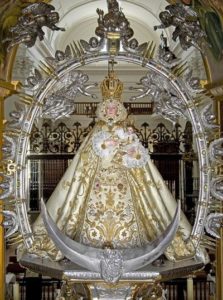
The image was canonically crowned by Pope Pius XII on 12 October 1955. Many copies of the image were sent to the Spanish colonies, including the famous Cuban version. The image celebrated 50 years of papal recognition with a Pontifical Mass in October 2005.
Virgen de la Caridad del Cobre in France
For centuries, the Church of Our Lady of Charity in France was the second largest church in Europe. This church was the home of the Abbey of Charity, a very large and famous Cistercian monastery. When the church was built in the 11th century, it was the second largest building in Europe, after the church at Cluny Abbey. The nave was shortened after a fire in 1559 destroyed the roof.

John Eudes founded the Order of Our Lady of Charity of the Refuge, an order that gave reformed prostitutes a decent place to live. The order survives today with many other charitable activities. Spin-off orders include the Apostolic and Contemplative Sisters of Our Lady of Charity of the Good Shepherd.
There was a pilgrimage chapel of Our Lady of Charity near Saint Laurent which was destroyed by order of the French revolutionary government in 1791. Shortly afterwards, the Virgin Mary was seen on the ruined altar and in a nearby oak tree. This led to an increase in pilgrimages and became part of the political instability that led to war in the Vendée. The church was inscribed on the UNESCO World Heritage List in 1998. It currently serves as a parish church dedicated to Our Lady of the Nativity.
Our Lady of Charity of El Cobre, Philippines
Our Lady of Charity or Virgen de la Caridad del Cobre is also found in the Minor Basilica of Agoo in the Philippines, this image was granted canonical coronation by Pope Paul VI on 1 May 1971.

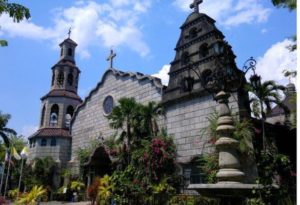
In the Philippines, Our Lady of Charity is known by her Spanish predecessor, Our Lady of Lacara (c. 1494), later known as Apo Caridad in the Ilocano language. The Marian title is not associated with the Cuban image, but rather with the ancient Marian image venerated in Toledo, Spain. Today these images are kept in the Basilica of Our Lady of Charity in Agoo.
Virgen de la Caridad del Cobre in the USA
On 8 September 1961, the Archdiocese of Miami celebrated the feast of Our Lady of Charity with 30,000 Cuban exiles at Miami Stadium. On the same day, a 16-inch replica of the statue of Our Lady of Charity was smuggled out of Cuba and arrived at the stadium.
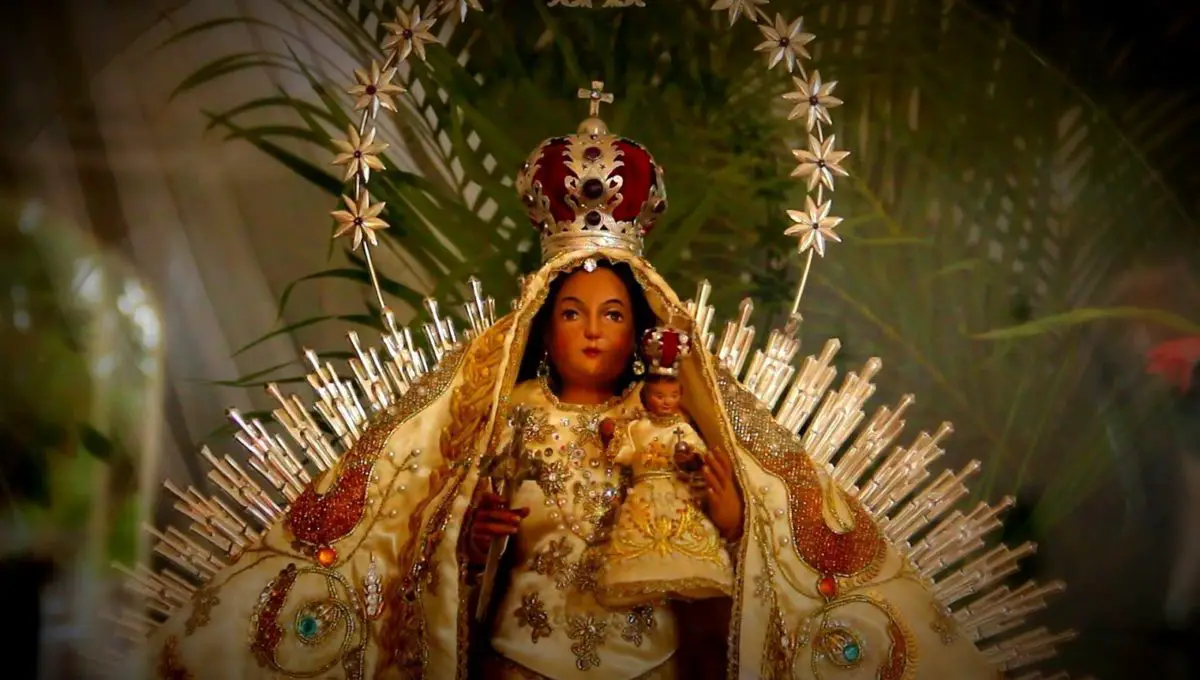
Because of the overwhelming Cuban devotion to this Marian title, the Archdiocese of Miami announced the construction of the Shrine of Our Lady of Charity in 1966. Construction began on the shrine, known as La Ermita de la Caridad, on the shores of Biscayne Bay in the Coconut Grove section of Miami. The shrine was completed in 1973 and was built with donations from new Cuban immigrants.

Other things to know about the Virgen de la Caridad del Cobre
- During Mass, the statue of the Virgin is mechanically turned inside the church so that it faces the congregation from high above the pulpit. After the service, it is turned to face the small chapel where it receives visitors. It is here that pilgrims come to venerate the image, present their petitions and leave votive gifts in gratitude for answered prayers and miracles.
- In a room on the ground floor are a variety of objects representing both prayer requests and answered prayers, including letters, locks of hair, wheelchairs, drip tubes, jogging trousers, posters, medals and even Ernest Hemingway’s Nobel Prize medal. A more recent gift was a young man’s degree dissertation, which he had asked Our Lady to help him finish.
The procession of the Virgen de la Caridad del Cobre in Cuba is one of the most beautiful. You can see it in the video below.
- During Pope Francis’ recent visit to the island, he said that the Virgin of Charity “has accompanied the history of the Cuban people, sustaining the hope that preserves the dignity of the people in the most difficult situations”. He said he went to El Cobre as “a son and a pilgrim”.

- Pope Benedict XV proclaimed the image and the Marian title Patroness of Cuba on 10 May 1916, at the written request of the veterans of the Cuban War of Independence.
- Pope Pius XI granted the image canonical coronation for the first time during the Eucharistic Congress in Santiago de Cuba on 20 December 1936, through Monsignor Valentín Zubizarreta y Unamunsaga.
- Pope Paul VI, through the papal legate Cardinal Bernardin Gantin, raised her shrine to the category of a minor basilica in the papal bull Quanto Christifideles on 22 December 1977.
It was solemnly crowned by Pope John Paul II during his Apostolic Visit on 24 January 1998.
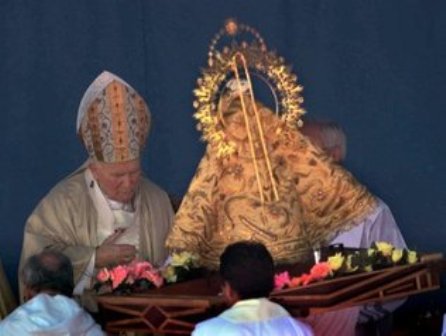
- On 27 March 2012, Pope Benedict XVI awarded a Golden Rose in honour of the image and its shrine.
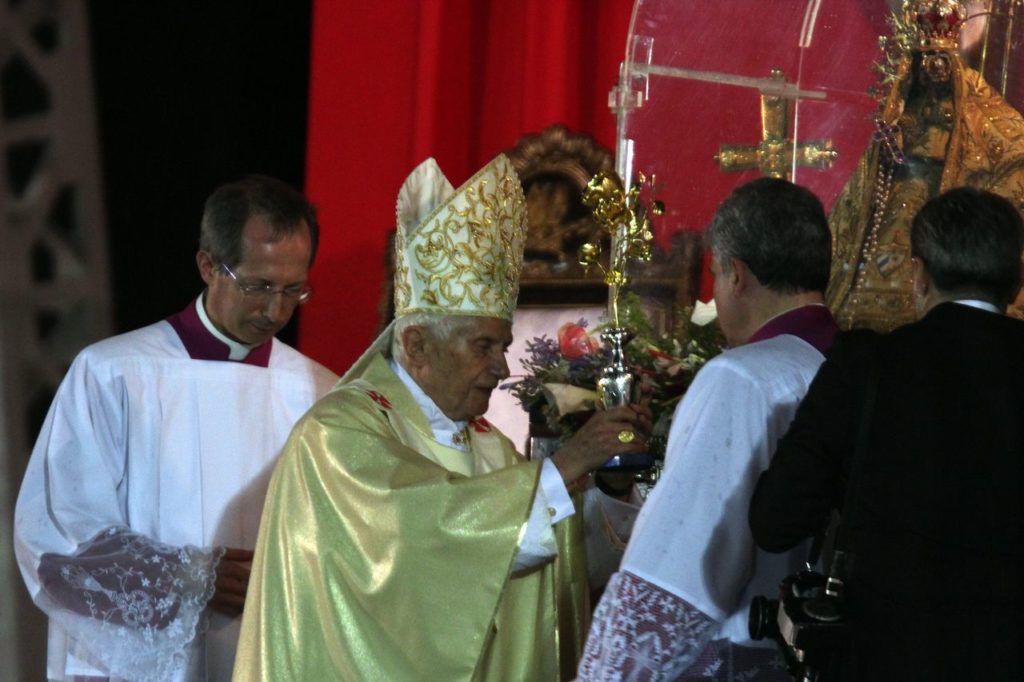
- In August 2014, Pope Francis consecrated in the Vatican Gardens a bronze statue presented to Pope Benedict XVI by the Bishops of Cuba (in May 2008). The image, in its thirteenth place, is one of the 14 Marian images that will remain permanently in the Gardens in 2016 by papal mandate of His Holiness.
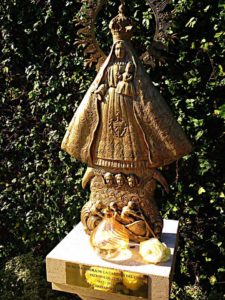
- In Mexico there is an event for tourists that consists of a trip to Contoy, it is a local tradition that is done by boat and now has a ferry, La Virgen de la Caridad del cobre is seen as the protector of the fishermen and this festival is held on her official day. She is taken by boat from Isla Mujeres and returned to the island in March, as is the Virgen del Valle in Venezuela.
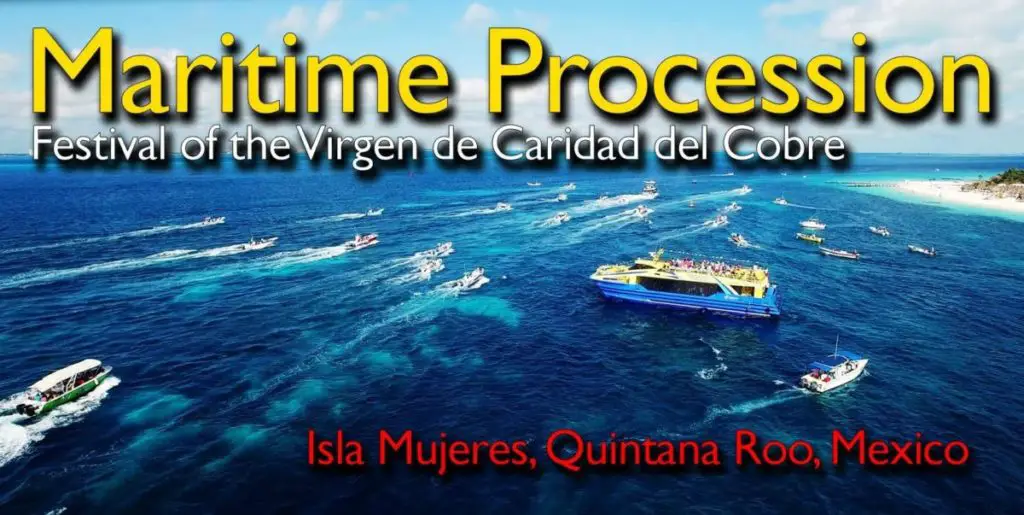
Finally, we leave you with the video of the Cuban song dedicated to the Virgen de la Caridad del Cobre, during her patron saint’s festivities in El Cobre, Cuba:

